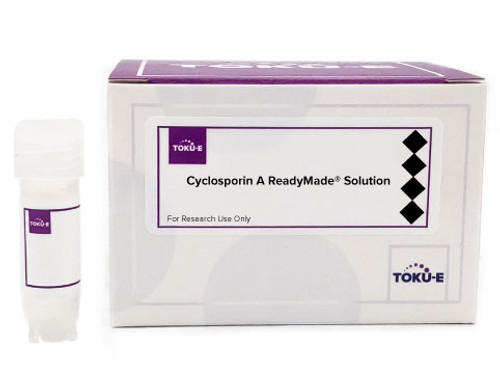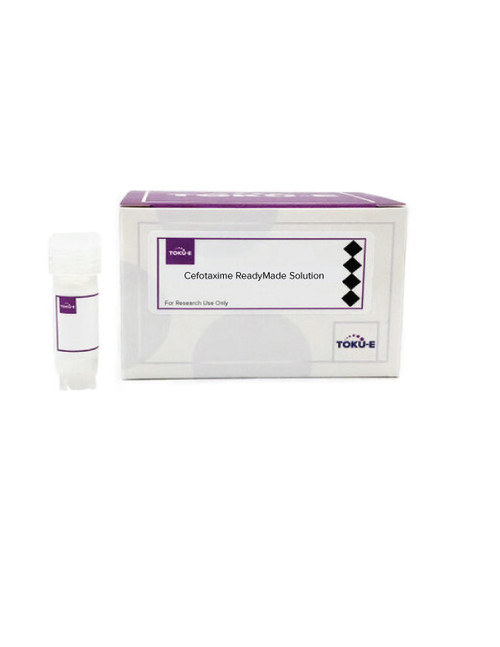Cyclosporin A ReadyMade™ Solution is a sterile-filtered (0.2 μm) solution of Cyclosporin A that has been dissolved in DMSO at a concentration of 5 mg/ml, ready for use in a variety of applications. Cyclosporin A is a natural product, a non-polar cyclic oligopeptide and calcineurin inhibitor with immunosuppressive properties. It was first isolated in 1971 from the fungus Tolypocladium inflatum. It can be used in organ-on-a-chip models to study nephrotoxicity and is also being studied for utility for coronavirus (SARS-CoV-2).
We also offer:
-
Cyclosporine A, EvoPure® (C042)
| Mechanism of Action | Cyclosporin A can inhibit function of many nuclear proteins involved in T-cell activation at the level of mRNA transcription. It forms a complex with cyclophilin, which can bind to calcineurin, a Ca2+- and calmodulin-dependent protein phosphatase, inhibiting its enzymatic activity. |
| General Applications | Cyclosporin A is a more improved gene selection agent. Disruption of the csr-1 gene, which encodes the Cyclosporin A-binding protein, leads to the resistance to Cyclosporin A. By cloning a gene of interest into a csr-1 knock-in vector and transforming a fungus with it, one can easily insert any gene, in single-copy, into a defined locus (Bardiya et al, 2007).
Cyclosporin A improves the selection of cells transfected with the puromycin acetyltransferase gene. The inclusion of Cyclosporin A, an inhibitor of multiple drug resistence proteins, restores puromycin susceptibility to intrinsically resistant cells, but not to cells transfected with the pac gene, thereby ensuring the unambiguous, rapid selection of transfected cell lines and lowering the concentration of puromycin required for selection in all cell lines (Zhang et al, 2002). |
| Microbiology Applications | Cyclosporin A was found to suppress hepatitis C replication in cultured hepatocytes. Cyclosporine has been shown to inhibit SARS-CoV replication at very low doses. Similarly, it inhibits the replication of other coronaviruses and HIV. There is a resemblance between SARS-CoV-2 and SARS-CoV based on the full-length genome. Further research is needed to understand its utility for SARS-CoV-2 (Cure et al, 2020).
Disruption of the csr-1 gene, which encodes the cyclosporin A-binding protein, leads to the resistance to Cyclosporin A. By cloning a gene of interest into a csr-1 knock-in vector and transforming a fungus with it, one can easily insert any gene, in single-copy, into a defined locus (Bardiya N. et al (2007) |
| Eukaryotic Cell Culture Applications | Cyclosporin A has been used to test its toxic effect on a 3D proximal tubule model on a perfusable organ-on-a chip model. Bioprinting is used to create 3D human renal proximal tubules in vitro. When Cyclosporin is introduced, this nephrotoxin causes disruption of the epithelial barrier in a dose-dependent manner. This system is useful for drug screening, disease modeling, and kidney organ engineering (Homan et al, 2016).
Cyclosporins have used as tools to study complex biological networks and pathways, involving protein function, and protein-protein interactions. Cyclosporin A had a suppressive effect on the Hepatitis C virus (HCV) replicon at the RNA level and HCV protein expression in cultured hepatocytes. Cyclosporin A also inhibited multiplication of the HCV genome in a human hepatocyte cell line infected with HCV using HCV-positive plasma (Watashi et al, 2003). Cyclosporin A has been used to establish Epstein-Barr virus-transformed human lymphoblastoid cell lines (Anderson and Gusella 1984). Cyclosporin's immunosuppressive properties and potential toxicity can be studied during in vitro assays. Other metabolites of Cyclosporin A (AM1, AM1c, DihydroAM1, AM19, and AM4N) can also be studied (Vollenbroeker B et al, 2005). |
| Molecular Formula | C62H111N11O12 |
| References |
Anderson MA and Gusella JF (1984) Use of Cyclosporin A in establishing Epstein-Barr virus-transformed human lymphoblastoid cell lines. In Vitro 20(11):856-858. PMID 6519667 Bardiya N and Shiu PKT (2007) Cyclosporin A-resistance based gene placement system for Neurospora crassa. Fungal Genet. Biol. 44(5):307-314 Carbajo-Lozoya J, Ma-Lauer Y, and Malesevic M (2014) Human coronavirus NL63 replication is cyclophilin A-dependent and inhibited by non-immunosuppressive cyclosporine A-derivatives including Alisporivir. Virus Res. 184:44-53 Cure E, Kucuk A and Cure MC (2020) Cyclosporine therapy in cytokine storm due to coronavirus disease 2019 (COVID-19). Rheumatol. Int. 40:1177-1179 Homan KA et al (2016) Bioprinting of 3D convoluted renal proximal tubules on perfusable chips. Sci Rep. 11(6):34845 PMID 27725720 Laupacis A et al. PA (1982) Cyclosporin A: A powerful immunosuppressant. Can. Med Assoc. J 126(9):1041-1046 PMID 7074504 Stiller, CR and Ulan RA (1981) Cyclosporin A: A powerful immunosuppressant. Can. Med. Assn. 126 (1981): 1041-046. Zhang G and Lyons JG (2002) Cyclosporin A improves the selection of cells transfected with the Puromycin acetyltransferase gene. Biotechniques, 33(1):32-36 |







